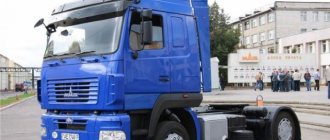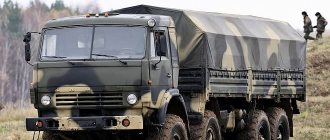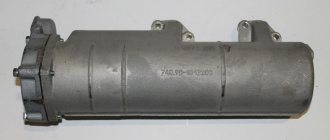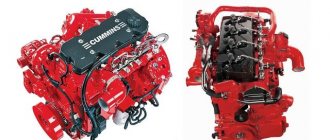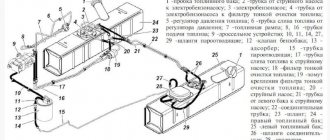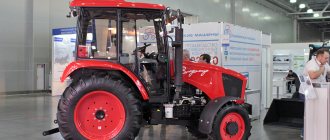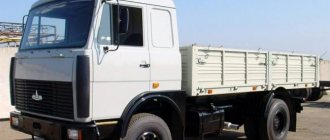Let's start with a little information and tell you what engines are currently installed on Chelny trucks and why. In Kamaz trucks you can find three units: the “native” diesel engine of the 740 series, as well as Daimler OM 457 and Cummins engines. The 740 engines are the only ones in the line with eight cylinders.
Imported engines are in-line sixes, like the future new P6. Such engines are now the most popular in the world of trucks. But once upon a time the 740 engine was quite an advanced unit! Let's remember his story. In 1967, the Moscow Likhachev plant began developing a family of ZIL-170 trucks with a 6x4 wheel arrangement. In 1969, the first sample was ready, and its production was transferred to a new plant in Naberezhnye Chelny, which at that time was still under construction. In 1976, the Kamaz-5320 rolled off the assembly line of the new enterprise, which in essence was the 170th ZiL. The power unit then was the Yaroslavl YaMZ with a volume of 11.5 liters, which produced from 180 to 210 liters. With. The production of these diesel engines was established at Kamaz back in 1975, and this is where the 740 series unit originates. What was good about this engine? Firstly, the Kamaz diesel engine is the first of the Soviet engines to receive a closed cooling system, which was supposed to use antifreeze rather than water. The drive of the radiator cooling impeller received a fluid coupling, and the entire system received a thermostat. There were other technological innovations in this engine (full-flow oil filtration system with a centrifuge, nitrided crankshaft, removable cermet guides for valves, etc.), but forty years have passed since then.
Engine KAMAZ P6 (KAMAZ 910)
Of course, over these decades the engine has been modified several times, but nothing can be altered endlessly: someday you will still have to invent something fundamentally new. Moreover, boosting an old engine has become simply expensive and therefore even more pointless. Add here the strict Euro-5 standards, a “Procrustean bed” that is too tight for the old V8. In a word, the need to create a new engine appeared a long time ago.
There are a lot of good straight sixes in the world. You can, of course, come up with another engine - Kamaz knows how and loves to invent something like that - but it would be unreasonably time-consuming and expensive. In modern automobile production, somewhat different trends have long been established, so they decided to look for a base for the new engine among other manufacturers with whom the company has established long-standing partnerships.
Why P6 and what does Liebherr have to do with it?
I have already said that the new Kamaz engine must necessarily comply with Euro-5, and in the future – Euro-6. It is difficult for a V8 engine to meet these standards in principle: a device with the complex and scary name of turbocompound “gets along” with it very poorly. What kind of animal is this? In an average diesel engine, about 30-40% of thermal energy flies out with exhaust gases, which you really want to somehow make work. For the first time, this trick was partially successful at Scania, which in 1961 installed a turbocharger on one of its engines. The device is familiar to most car enthusiasts: very briefly, it uses exhaust gases to pump additional air into the combustion chamber. Not bad, but not enough. And then they came up with a turbocompound.
Its task is somewhat different: it transfers gas energy directly to the crankshaft through a fluid coupling and a reduction gearbox. It can be said to take mechanical energy out of nowhere and deliver it directly to the shaft. This - to explain in a nutshell, in reality everything is much more complicated and interesting, but we will not delve into the theory of engine building and the features of engine operating modes under load and without it. Let’s just accept the fact that this thing is very useful and effective, with its help you can significantly increase engine efficiency, and most importantly, meet strict environmental standards, not only present ones, but also future ones. Turbocompound is found on many trucks, primarily, of course, on Scania, but there is, for example, also on Volvo. Today, the opinion on the need to install a turbocompound unit on internal combustion engines in trucks is almost unambiguous: it must be installed. Only on a V8 with its extremely complex exhaust system, installing a turbo compound turns out to be a difficult and useless task. Firstly, it will be expensive, and secondly, the turbo compound will increase the already significant dimensions of the engine. The in-line layout is another matter: here, with the installation of a miracle device, everything is much simpler.
There is another argument in favor of the inline six - its cost. The fact is that the V8 is an unbalanced engine, and to reduce vibrations it is necessary to install additional balancer shafts. They not only reduce efficiency (part of the energy of burned fuel is spent on rotating the shafts), but also increase the cost of the engine. But the R6 is precisely the most naturally balanced engine; in principle, it does not need balance shafts. Of course, the motor design becomes simpler and cheaper. Balance, relative simplicity of design and low production cost became the main arguments in favor of the in-line layout of the future engine. So, this seems to be clear. Now a few words about Liebherr. Back in 1973, three years before the launch of production of the first vehicles, the German company Liebherr (read “Liebherr” in Russian) became a partner of the USSR in the design of a separate production of Kamaz - the production of gearboxes. Since then, cooperation with this manufacturer has almost never stopped and has always been profitable and constructive.
Just remember what engines are on the Dakar KamAZ-4326? That's right, Liebherr. A good reputation and not too great demands from the German partner allowed us to consider the Liebherr D946 engine as the basis when choosing a new engine. But don’t think that the new P6 is a copy of the German unit. Development was carried out jointly, but with an eye on the D946. So what kind of engine will we expect from Chelny residents?
Engine makers are returning to straight sixes
Long-time supporters of V-shaped diesel engines for trucks Mercedes-Benz and Scania are planning to curtail their production in favor of in-line sixes for a reason. This is primarily due to the design features of engines of Euro 6 and higher levels. There are a lot of good straight sixes in the world. To neutralize exhaust gases, to optimize the settings of electronically controlled diesel fuel systems, a combination of exhaust gas recirculation (EGR), urea water injection (SCR) and a regenerable particulate filter will not be enough. Experts agree that these systems will have to be supplemented with a turbo compound. That is, by installing another turbine, which additionally tightens the crankshaft through a viscous coupling and a reduction gearbox, and without wasting fuel. Free power allows you to effectively use the engine for the sake of the environment without any problems.
The new KAMAZ engine is created on the basis of a 12 liter Liebherr D946 diesel engine, which has been on the assembly line for only two years and is used only on construction equipment, but not on cars. Structurally, the Liebherr D946 is similar to many in-line diesel engines: it has a cast iron block, wet liners (this is traditional for any Liebherr diesel engines), the camshaft is located in the block, the valve drive is by rods, timing gears and pumps are on the flywheel side. The working volume is 11.95 liters, the dimension is 130x150 mm, that is, KAMAZ departs from the usual piston diameter of 120 mm.
KAMAZ P6 engine designs
Firstly, the engine is diesel. If anyone doesn’t know, the ignition of the mixture in such an engine occurs from compression. The compression ratio of the new engine is 18. Fuel injection is direct into the combustion chamber located in the piston. With a cylinder diameter of 130 mm, the piston stroke will be 150 mm - such engines are called “long-stroke”. By the way, previous Kamaz-740 engines were also long-stroke - 120x130 mm. The resizing resulted in nearly the same volume being maintained while reducing the number of cylinders.
There is nothing new in the cooling system - a conventional liquid one with forced circulation, the volume is 20 liters. The charge air supercharging and cooling system is gas turbine, with single-stage supercharging and an air-to-air heat exchanger. The lubrication system is combined, with a gear oil pump and a water-oil oil cooler. At the moment, the fuel system is perhaps the most difficult thing to localize. At first glance, there is not much new here either: Common Rail with a high-pressure multi-piston pump. But the most important components are still imported: injection pump, injectors, ECU - all this remains from Liebherr. And the turbocharger is from the same company. In total, foreign suppliers account for about a quarter of the positions, the rest is either produced at Kamaz or ordered from domestic specialized enterprises. The Kamaz engine plant has already carried out test castings of the cylinder block. This is carried out in conjunction with the “scroll” of the cooling system pump and the mounting flanges of the liquid-oil heat exchanger, fuel injection pump and brake system compressor. In order to increase rigidity, the block has ribs. In general, special attention was paid to the rigidity of the block: the Liebherr D946 diesel was heavy - it was mostly used in construction equipment and as a stationary unit, so it had to reduce weight. Of course, rigidity should not suffer from this.
P6 has individual cast-iron cylinder heads, which simplifies possible repairs (even replacing one gasket on an individual head is easier and cheaper than replacing a common cylinder head). The main and connecting rod journals of the crankshaft are treated with high frequency currents. The upper compression and oil control rings are chrome-diamond coated, but the lower compression ring is uncoated. The design of the oil pump not only allows oil to be supplied to the main components as quickly as possible, but also ensures internal recirculation of excess oil. The pump itself is gear type, single-section and located in the oil sump. By the way, the pallet itself can be not only metal, but also plastic - work on its introduction into production is currently underway at KamAZ. And now the most interesting thing: how will the production of the new engine be organized in Naberezhnye Chelny?
P5ZV7378_new size
The flywheel housing is made according to the SAE1 standard - you can install here not only an Allison Transmission hydromechanical transmission, but also any ZF gearbox, up to Traxon.
The flywheel housing is made according to the SAE1 standard - you can install here not only an Allison Transmission hydromechanical transmission, but also any ZF gearbox, up to Traxon.
Lead bronze liners will have an additional anti-friction wear-resistant layer (PVD coating), which will be applied by ion-vacuum sputtering. Moreover, such sliding bearings will be manufactured at the Dimitrovgrad liner plant, which was recently acquired by Federal-Mogul.
Based on the new KAMAZ-910.10 engine, various modifications will be created - with a power of 380, 400, 450, 500 and 550 hp. With. at 1900 rpm. Torque - from 1700 to 2540 Nm, with a shelf in the range of 1100–1400 rpm.
In Europe, and especially in Russia, the most popular power range is 440–480 hp. With. - both on vehicles for long-haul transportation, and on construction trucks, up to four-axle vehicles.
Turbo engine KAMAZ | KAMAZ
The sound of a KamAZ turbo engine
KamAZ 6x6 with YaMZ-238 turbo engine
turbo engine for Kamaz
Kamaz with YaMZ turbo. I continue to assemble the YaMZ-238-d1.No.2 engine
Kamaz with YaMZ turbo. Sandblasting, primer YaMZ 238d1 engine.
Kamaz with YaMZ turbo. I continue assembling the YaMZ-238-d1 engine
Kamaz with YaMZ turbo. Preparation of the YaMZ 238d1 engine for sandblasting.
ZIL-131 MAN turbo engine
Ural 4320 engine MAZ six turbo.
The “worst” Japanese engine turned out to be quite reliable: Daihatsu 1.3 (K3-VET) Turbo
Also see:
- Purpose and technical characteristics of KAMAZ
- Technical data of KAMAZ vehicles
- Bundle of wires for KAMAZ 65116
- How to change the oil in a KAMAZ gearbox
- Instrument cluster KAMAZ 44108 24
- Permissible axial play of the KAMAZ crankshaft
- KAMAZ 43118 side length
- Possible malfunctions of the KAMAZ transmission
- Platform KAMAZ 65111
- Adjusting the injectors on KAMAZ
- Connecting rod material KAMAZ 740
- Curtain on the windshield of KAMAZ
- Motor for KAMAZ stove
- Location of the starter relay on KAMAZ
- Plus generator brushes KAMAZ
Home » New items » Turbo engine KAMAZ
kamaz136.ru
Engines and power units
Engine models Emissions compliance standards Cylinder diameter x piston stroke, mm Operating. volume, l nnom, min-1 Ne, hp Micromax, kgf*m Min specific fuel consumption, g/hp˙h Oil consumption for waste, no more than, % of fuel consumption Service life, thousand km of vehicle mileage Design features
| 740.75-440 | Euro-4 (UNECE Regulation No. 49-04B1) | 120×130 | 11.76 | 1900 | 440 | 206 | 194.5 | 0.06 | 1000, as part of long-haul vehicles | Diesel, turbocharged, ONV, electronically controlled and Common Rail type fuel supply and exhaust gas treatment systems |
| 740.74-420 | 420 | 186 | ||||||||
| 740.73-400 | 400 | 176 | ||||||||
| 740.72-360 | 360 | 157 | ||||||||
| 740.71-320 | 320 | 137 | ||||||||
| 740.70-280 | 280 | 117 | ||||||||
| 820.73-300 | Euro-4 (UNECE Regulation No. 49-04B1) | 120×130 | 11.76 | 1900 | 300 | 140 | 154 | 0.17 g/(hp•h) | 800, as part of long-haul vehicles | Gas, turbocharged, ONV, electronically controlled and exhaust gas treatment system |
| 820.72-240 | 240 | 110 | ||||||||
| 820.74-300 | 300 | 125 | ||||||||
| 820.60-260 | 2200 | 260 | 110 | 0.33 g/(hp•h) | ||||||
| 820.61-261 | 95 | |||||||||
| 740.662-300 | Euro 4 (UNECE Regulation No. 96-02) | 120×130 | 11.76 | 1900 | 300 | 127 | 207 | 0.1 | 450, as part of all-wheel drive vehicles | Diesel, turbocharged, ONV, electronically controlled and “Common Rail” fuel supply system |
| 740.642-420 | 420 | 186 | ||||||||
| 740.632-400 | 400 | 176 | ||||||||
| 740.602-360 | 360 | 157 | ||||||||
| 740.612-320 | 320 | 137 | ||||||||
| 740.622-280 | 280 | 117 | ||||||||
| 740.652-260 | 260 | 112 | ||||||||
| 740.64-420 | Euro-3 (UNECE Regulation No. 49-04A) | 120×130 | 11.76 | 1900 | 420 | 186 | 207 | 0.1 | 800, as part of long-haul vehicles | Diesel, turbocharged, ONV and electronically controlled |
| 740.63-400 | 400 | 180 | ||||||||
| 740.60-360 | 360 | 157 | ||||||||
| 740.61-320 | 320 | 137 | ||||||||
| 740.62-280 | 280 | 118 | ||||||||
| 740.65-240 | 240 | 98 | ||||||||
| 740.30-260 | Euro-3 (UNECE Regulation No. 96-01) Euro-2 (UNECE Regulation No. 49-02B) | 120×120 | 10.86 | 2200 | 260 | 107 | 207 | 0.2 | 800, as part of long-haul vehicles | Diesel, turbocharged and ONV |
| 740.31-240 | 240 | 93 | ||||||||
| 740.35-400 | 120×130 | 11.76 | 1900 | 400 | 157 | 201 | ||||
| 740.50-360 | 360 | 147 | ||||||||
| 740.51-320 | 320 | 127 | ||||||||
| 740.52-260 | 260 | 107 | ||||||||
| 740.53-290 | 290 | 122 | ||||||||
| 740.55-300 | 300 | 118 | ||||||||
| 740.37-400 | 400 | 176 | 204 | |||||||
| 740.38-360 | 360 | 160 | 148 | |||||||
| 740.13-260 | Euro-1 (UNECE Regulation No. 49-02A) | 120×120 | 10.86 | 2200 | 260 | 93 | 207 | 0.3 | 800, as part of long-haul vehicles | Diesel, turbocharged |
| 740.11-240 | 240 | 83 | ||||||||
| 7403.10 | Euro-0 (UNECE Regulation No. 49-00) | 120×120 | 10.86 | 2600 | 260 | 80 | 155 | 0.8 | 400 | |
| 740.10-20 | 220 | 68 | 0.6 | Diesel | ||||||
| 740.10 | 210 | 68 |
kamaz.ru
The P6 inline six is getting ready to roll off the assembly line.
The initial stage of installing the equipment necessary to assemble an engine of a completely new type of inline six P6 has begun, the portal kamaz.ru reports.
The initial stage of installation of the equipment necessary for assembling an engine of a completely new type - the P6 inline six - has begun, the portal kamaz.ru reports.
In total, 14 contracts for the supply of equipment were concluded, said Fedor Nazarov, chief engineer of KamAZ PJSC. When choosing a supplier, the plant was guided by quality, not price, Nazarov noted. Thus, contracts were signed with Italy, Austria, England, Serbia and Germany. It is expected that this year the plant will receive about 60 units of high-tech and modern equipment equipped with video surveillance and tracking systems.
To install such complex equipment, a special foundation is required, so large-scale construction work is currently underway on the “engines”. It is planned to place large production lines at four sites, which will process the block and cylinder heads, as well as assemble, dock and paint the engine.
Construction in workshop 116, in the cylinder head processing area, has already come to an end; a special commission has accepted the foundation. In addition, installers from Germany are currently installing Heckert equipment on the line. This section includes seven machining centers responsible for machining, subassembly and testing of this part. Project manager Vladimir Barinov noted that the line will use two machines already available at the plant. Due to the fact that the block head is made of cast iron and weighs 25 kilograms, manual labor in this area is planned to be minimized as much as possible, Barinov emphasized.
In addition, construction work has been completed on the line where the new engine will be assembled. Equipment for it will begin to be installed in March. Construction is still underway on the cylinder block line and the docking line. The area where the engine painting line will be located will require a particularly large amount of work. It is worth noting that in the future this area will be used not only for painting P6, but also for all products produced by KamAZ. The equipment for these two lines is expected to be delivered in March-April.
This year it is planned to produce 200 prototypes of new engines. This will allow us to check the stability of all processes so that in the future the plant can switch to mass production of products.
politeexpert.net
